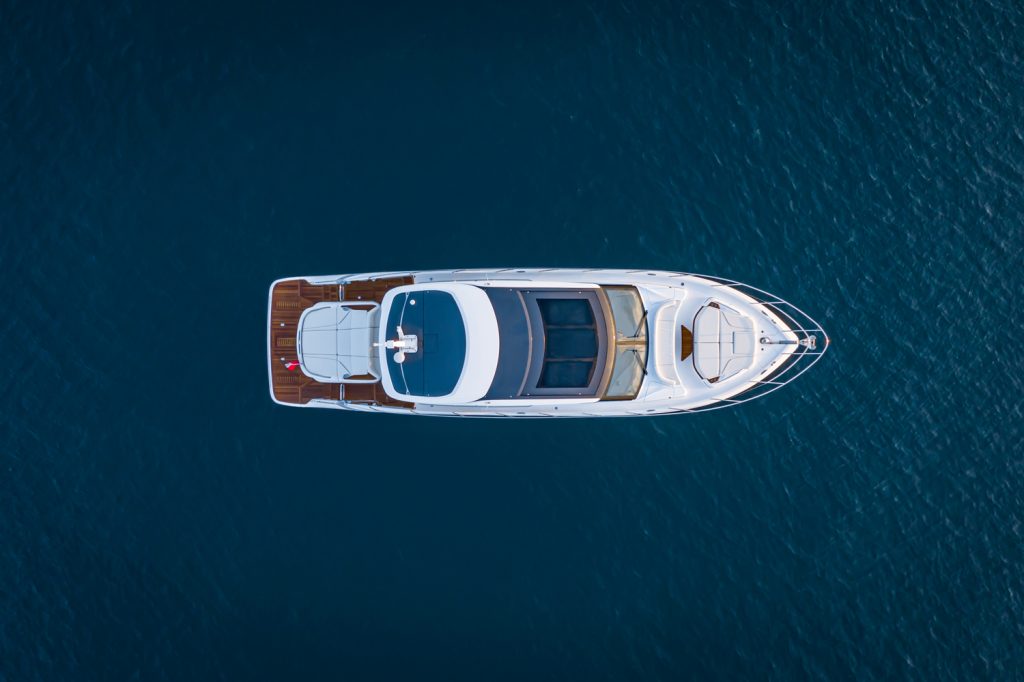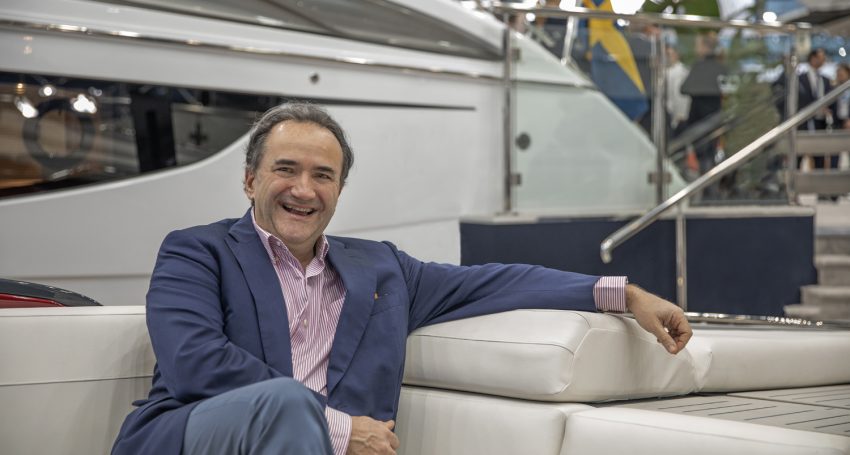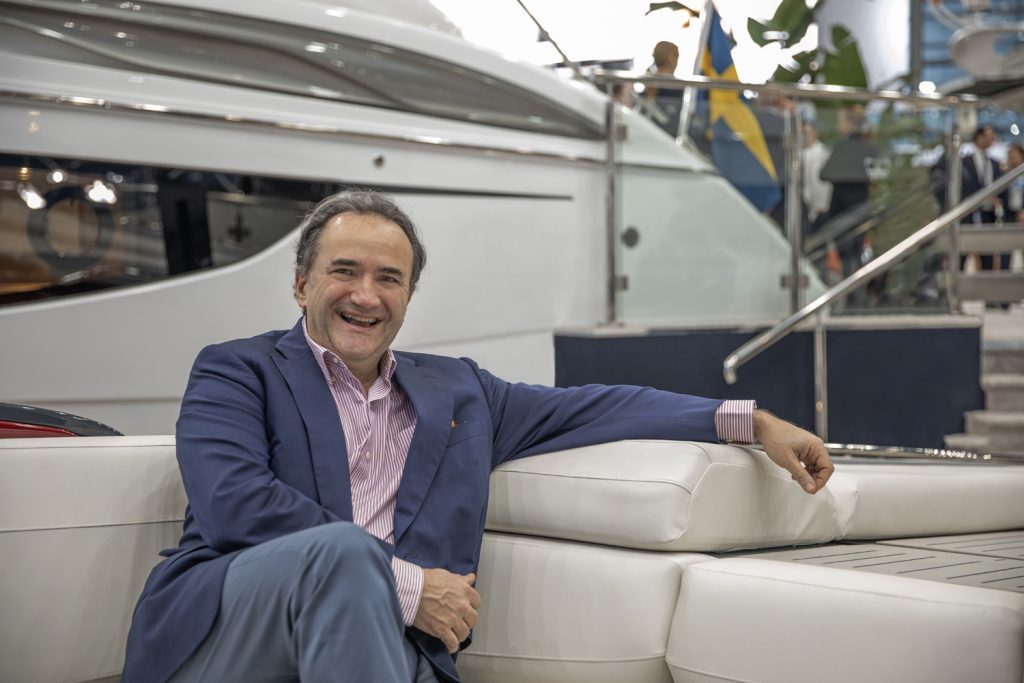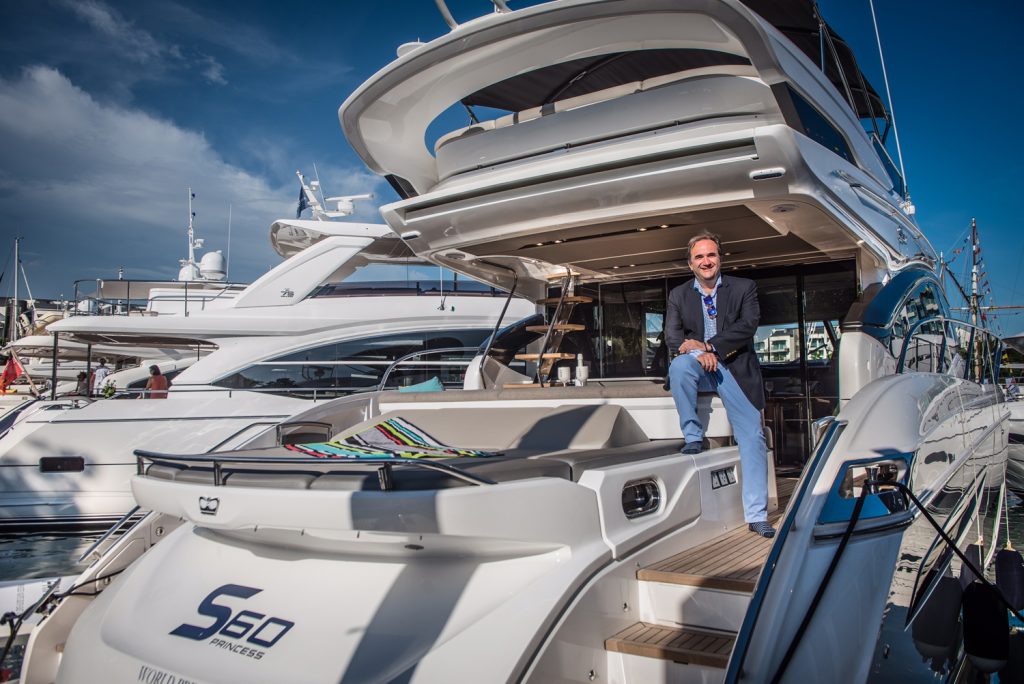Antony Sheriff joined the British luxury yacht manufacturer Princess Yachts in January 2016, after a decade as Managing Director of the luxury car manufacturer McLaren Automotive.
In 2018, Princess Yachts announced record turnover, up 27 percent on the previous year to £274.4 million. Princess continued the success story with record-breaking results for sales at the 2019 boot Düsseldorf, the world’s biggest indoor boat show.
In May 2019, Princess Yachts again saw record financial results, this time of £340m turnover and £30m in operating profit. These figures are underpinned by record levels of productivity and employment at 3,200, up 50 percent since 2016.
We talked with Antony Sheriff about the history of the brand, uniqueness of Princess Yachts and key trends in the industry today.
Let’s talk a bit about the history of the company. How did it all begin?
The Princess brand was founded in 1965 by David King, who still comes to the office on a weekly basis and contributes to the design of all the boats we are working on.
He still has the same passion as when he founded the company. Princess is one of the oldest motor yacht brands, and we are very proud that we have been operating in exactly same location ever since it was found.
Our company maintains its roots and heritage which are crucial to the brand. The boats are built in Plymouth (UK), where we have a very strong culture of how we think about boats and how we build boats. We always keep in mind that the company was founded to build serious boats which helps to keep the seakeeping of our yachts at a fantastic standard.
You cannot get out of Plymouth harbour unless you have solid seakeeping ability, as the weather there is quite bad. The idea is making everything by hand, just as our first boat was, and is something that we still do today even though we make 250 boats a year.
We employ 3,000 people in Plymouth to do this and, no matter what type of boat we make, the process of what we do is pretty much the same as it was in 1965.
Tell us about the unique features that characterise Princess Yachts.
When we talk about designing a new yacht, there are a number of things we keep in mind; one is the seakeeping which has to be fantastic. We are very serious about the nautical qualities of our boats: the boat needs to be stable, comfortable and safe in all conditions, especially in the environment in which we live, where the waters are considerably rougher than the Mediterranean sea, so we design our boats for that environment.
The second, which is very important, is that we are designing yachts for boaters. This means that, above all, it has to be a yacht that functions well as a boat, with a lot of storage space, where things are exactly where you expect them to be. We do not want to sacrifice usability for style.
Our boats still maintain very strong degree of rationality and functionality in the way that they work and we do that through a very clever design of the architecture of the boat. So when you get on a Princess yacht, your reaction should be: “This boat looks larger than it is.”
Everything looks simple, in its place, the walls are vertical and the floors are flat, while a lot of other yachts have many intrusions and protrusions that do not allow extra space.
What I always like to say is: “It is very simple to make things look complicated, but it is very complicated to make things simple.”
So this knowledge of how to keep things simple and how to create a uniform space is really one of our core assurances, based on our 56 years of experience in designing great yachts. Now all of that means we make yachts with great quality of space, seakeeping ability and lots of storage, but that doesn’t mean we only make functional boats.
We also make very beautiful boats. Princess Yachts has always been characterised by a degree of British understatement. It has never been classified as ultramodern, or something that people would say they hadn’t seen before.
You can be modest and elegant without going over the top, so we have been working very hard for the past few years to try to take this image of understated elegance and to build boats which are a bit more modern in their interpretation but, more than modern, to have higher design quality.
I have a background which is originally outside of the boating industry and the level of design quality in the boating industry is not what would be normal in the automotive industry, where there is a lot more time spent on surfacing forms and making sure the reflections work out nicely and that the product is much more sculptured and detailed.
We put a lot of work into that. We have been working with a company calling Pininfarina, in addition to our design team, trying to take this level of beauty to a much higher degree of satisfaction. That is the case with the latest model we are launching, the yacht Y72. It is very much a “princess”, instantly identifiable as a Princess yacht, with no sacrifice of functionality or seakeeping, but much more beautiful than the boats that came before it.
What are the key trends in yachting in your opinion?
Firstly, I will tell you the things we are focusing on. The first is to try to reduce the carbon footprint of the boats and it doesn’t mean making hybrid boats or electric boats, although we are looking at all of that, but just over the last year we have done the complete review of our hull designs. If you look at our X-95, the resistance on the water is 18 percent lower than the ancestry boat and it has better seakeeping as well.
So we are trying to develop our architecture to have better seakeeping than the yachts that are being replaced, but significantly better resistance through the water. By doing this, if you are less resistant in water, you consume less fuel in the water which has a very positive impact on the carbon footprint of the yacht. You also see this technology on the R35 where we used a unique hull form system with active foils in order to reduce, in that case, the resistance of the water on the cruising speed by 30 percent. So these are the technologies we are not only looking at but investing in and putting into the market. Another type of technology is that which makes the boat less intimidating and more expansive.
I take the analogy of sports supercar market, which I know well from my past experience. The growth in that market came when the supercars became easier to drive. When they had manual transmission and no traction control, no air conditioner, they were very intimidating to drive and now anybody can drive it because it’s easy; the transmission is now automatic, has stability control, and others aspects that helped it to become more accessible.
We need to implement the same to the yachts. Certain technology, such as joystick control, allows much easier control for the captain and also other things like an automatic docking system for example.
What is the most terrifying experience of the boat? It is docking. Imagine you are coming back to the dock and everybody in the tavern is watching how much damage you are going to do to your boat and the other ones near you.
So if we can make these things more accessible, you will not have to worry about it, the technology will do it for you, that’s what I think is going to be a very important trend, when it becomes more accessible to more and more people.
Don’t you think there is a future for electric and hybrid yachts and what is Princess doing in this area?
It’s a very good question. People will often look to the automotive industry and think, if cars can be electric and hybrid, why can’t boats do the same. It doesn’t work that way. The cars which are hybrid have a good carbon footprint because they are often starting and stopping, the engine turns on and off at a traffic light; it is all electric if you are driving below 30 km/h and so when you go to a highway the engine turns on. So in terms of the actual drive cycle of the car, it makes a lot of sense.
The quiet secret of hybrid cars is that, on the highway, they actually consume more than a normal car, because they are also carrying a battery, but the battery is useful when you stop. The problem with boats is that they won’t start and stop, boats go at a constant speed, cruising speed, and then stop, so a hybrid boat wouldn’t actually do much.
There are hybrids which allow you to go in and out of harbours electrically but, in terms of the amount of fuel you save, it is not much, it’s more for show than anything else.
Similarly with electric, if we could design an electric boat that will absolutely be the solution but the problem is that in order to have a fully electric boat with the same range you probably need another boat just to carry the battery. And there are no charging stations in the middle of the sea, so if you ran out of battery power you’ll have a problem. It doesn’t mean let’s forget about it, what needed is a different approach. We have to think what the propulsion system would be like for a yacht and how that might work that will give you completely carbon free performance in certain aspects, very low emission and still get the performance you need, so there are very interesting things we are working on now. If we make a hybrid boat, then it won’t be the same concept as a hybrid car. Maybe it will be different power sources in order to manage the boat in different cases, so you can get lower carbon footprints in everyday use. We do not have any hybrid solutions in our company at the moment but we are working on something similar which will be uniquely ours.
What are the types of yachts produced in your company?
We make yachts from 40 foot up to 95 foot. We have different lines of yachts according to type of usage, from very spacious and functional to very sporty. The sporty boats are our V classes and S classes, the difference is with the flybridge. The S class has a flybridge and the X class doesn’t. They tend to be quick and beautiful and they still have a good usability, it is very much about the outdoor lifestyle. We then have the traditional flybridge boats which are F class and Y class, the difference is that Y class has bigger boats and they have a higher level of specification than the smaller F class boats. Y class boats are more elegant without losing the value of what the traditional Princess boats have and it is a very good mixture between the indoor and the outdoor space in its traditional form; big flybridges, big saloons, very good accommodation, a nice cockpit, a very beautifully designed boat. Then the most interesting new class is the X class, which is our most functional boat, but not necessarily functional in terms of simplicity but also in terms of its sportiness.
We managed to maximise the space of this yacht to the extent that our new 95 foot boat has the same amount of space as our previous boat of 116 feet, and we have done so by completely rethinking the layout of the boat.
We extended the full length of the deck and created a saloon which is almost 25 metres long, and then once we extended the saloon it also allows us to expand the flybridge, and put the sky lounge in the middle. There is a deck in the rear, in the front and you can walk around the whole boat. So on a boat with a length of 30 metres, it feels like a 60 or 70 metre-length yacht. So we do have a broad range of boats, we make 18 different E and X class yachts from 40 feet all way to 95 feet.

Can you tell us about your initiatives for marine conservation?
That’s very important to us. We make products which live on the sea, the people that use our products like to live on the ocean because it’s a beautiful place and we have to make sure it stays a beautiful place so we have a number of different initiatives.
We are the first yachting company ever to support the Marine Conservation Society which is the UK’s leading marine environment non-profit organisation and it works for protecting the seas around the UK by creating marine protection areas.
We raise money for this and to a lot of other such initiatives, including with our partners: Seabobs, which are zero emission water toys, and we have arrangements with Hummingbird which make foldable bikes. Whenever they sell something, some percentage goes to the charity for marine protection. Not only do we do it ourselves, we also engage our partners to do it too. We did a whole project protecting turtles in Turks and Caicos, and we go around the world and look where our contribution can make a difference and where we can help the environment. This is our obligation and this is the environment in which we live in as a yacht manufacture.
Who is the client who chooses Princess Yachts?
I think the people that buy Princess are the people who are buying not to show off, but to have a great boat. They are boaters and they understand that something which is flashy may not be a great boat and I think they are not necessarily the customers that are looking for the least expensive boat or the flashiest boat, but the ones who look for the best boat and have a degree of modesty. All of them are from different backgrounds, different ages, different professions, the people who use our boats are people who like boats, and treat them well. We have customers everywhere, from the United States to South Africa, from Cyprus to Russia. And what ties them together is the boat of their life that they are looking for.





